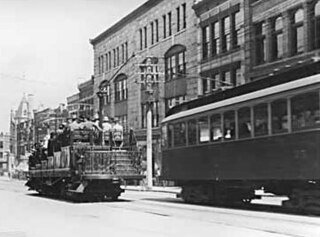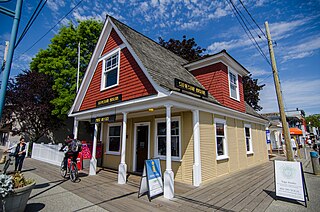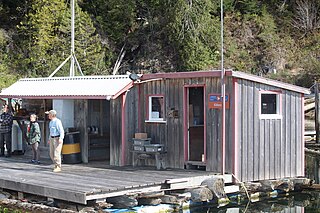
Richmond is a city in the coastal Lower Mainland region of British Columbia, Canada. Mainly a suburban city, it occupies almost the entirety of Lulu Island, between the two estuarine distributaries of the Fraser River. Encompassing the adjacent Sea Island and several other smaller islands and uninhabited islets to its north and south, the suburb neighbours Vancouver and Burnaby on the Burrard Peninsula to the north, New Westminster and Annacis Island to the east, Delta to the south, and the Strait of Georgia to the west.

The British Columbia Electric Railway (BCER) was an historic railway which operated in southwestern British Columbia, Canada. Originally the parent company for, and later a division of, BC Electric Company, the BCER assumed control of existing streetcar and interurban lines in southwestern British Columbia in 1897, and operated the electric railway systems in the region until the last interurban service was discontinued in 1958. During and after the streetcar era, BC Electric also ran bus and trolleybus systems in Greater Vancouver and bus service in Greater Victoria; these systems subsequently became part of BC Transit, and the routes in Greater Vancouver eventually came under the control of TransLink. Trolley buses still run in the City of Vancouver with one line extending into Burnaby.

Richmond Centre is a federal electoral district in British Columbia, Canada, that has been represented in the House of Commons of Canada since 1988.

The Musqueam Nation is a First Nation whose traditional territory encompasses the western half of what is now Greater Vancouver, in British Columbia, Canada. It is governed by a band council and is known officially as the Musqueam Indian Band under the Indian Act. "Musqueam" is an anglicization of the Hunquminum name xʷməθkʷəy̓əm, which means "place of the river grass" or "place where the river grass grows".

Lulu Island is the name of the largest island in the estuary of the Fraser River, located south of Vancouver, British Columbia, Canada, and the second-most populous island in British Columbia, after Vancouver Island. The city of Richmond occupies most of the island, while a small section at the eastern tip, known as Queensborough, is part of the city of New Westminster.

The 98 B-Line was a bus rapid transit line in Metro Vancouver, British Columbia, Canada, that began service in September 2000. It linked Richmond to Downtown Vancouver, with a connection to Vancouver International Airport. It travelled mainly along Granville Street in Vancouver and a dedicated bus lane on No. 3 Road in Richmond. It was operated by Coast Mountain Bus Company and was funded by TransLink. The route was 16 kilometres (9.9 mi) long. The line carried over 18,000 passengers daily. It was discontinued in September 2009, shortly after the opening of the Canada Line, which replaced it.

Marpole, originally a Musqueam village named c̓əsnaʔəm, is a mostly residential neighbourhood of 23,832 in 2011, located on the southern edge of the city of Vancouver, British Columbia, immediately northeast of Vancouver International Airport, and is approximately bordered by Angus Drive to the west, 57th Avenue to the north, Ontario Street to the east and the Fraser River to the south. It has undergone many changes in the 20th century, with the influx of traffic and development associated with the construction of the Oak Street Bridge and the Arthur Laing Bridge.

The history of Vancouver, British Columbia, is one that extends back thousands of years, with its first inhabitants arriving in the area following the Last Glacial Period. With its location on the western coast of Canada near the mouth of the Fraser River and on the waterways of the Strait of Georgia, Howe Sound, Burrard Inlet, and their tributaries, Vancouver has – for thousands of years – been a place of meeting, trade, and settlement.

Dunbar–Southlands is a neighbourhood situated on the western side of Vancouver, British Columbia, Canada, that stretches north from the Fraser River and covers most of the land between the mouth of the Fraser and English Bay.

The Marpole CP Rail Bridge is a partially dismantled crossing over the north arm of the Fraser River, and River Dr., in Metro Vancouver.

The Gulf of Georgia Cannery is a National Historic Site of Canada located in Steveston village in Richmond, British Columbia.

Brighouse is a neighbourhood that comprises most of the urban core of Richmond in Metro Vancouver. The area includes community facilities, civic offices, Richmond Centre, and the Canada Line Richmond–Brighouse station terminus.

The Marpole Midden, also known by archaeologists as the Great Fraser Midden or Eburne site, is a 4000-year-old midden at the mouth of the Fraser River, in the Marpole neighbourhood of Vancouver, British Columbia. The site was the location of the ancient Musqueam village of c̓əsnaʔəm and a sacred burial ground.

The Steveston Museum is located at 3811 Moncton Street in the heart of the village of Steveston, British Columbia, Canada. The building is owned by the City of Richmond and is run by the Steveston Historical Society. Erected in 1905 during a cannery boom period, the building housed Steveston's first bank.

Kildonan is an unincorporated community in the Alberni Inlet-Barkley Sound region of the west coast of southern Vancouver Island, British Columbia. The former steamboat landing and ferry dock is on the east shore of Uchuchklesit Inlet, which branches northwest of the lower reaches of Alberni Inlet. Adjacent to Pacific Rim National Park Reserve, the locality is by road and ferry about 120 kilometres (75 mi) southwest of Port Alberni.
Tomekichi "Tomey" Homma (1865–1945) was a Canadian who was one of the first Japanese settlers of Steveston, which is now part of Richmond, British Columbia. He fought for the right to vote for Japanese-Canadians in provincial elections.
Diamond Point is a contemporary Coast Salish artist and member of the Musqueam Indian Band.
The Japanese martial art and combat sport judo has been practised in the Canadian province of British Columbia since the early 1900s, and it was the only place in the country where judo was practised prior to the Second World War. The first long-term judo dojo in Canada, Tai Iku Dojo, was established by a Japanese immigrant named Shigetaka "Steve" Sasaki in Vancouver in 1924. Sasaki and his students opened several branch schools in British Columbia and even trained RCMP officers until 1942, when Japanese Canadians were expelled from the Pacific coast and either interned or forced to move elsewhere in Canada due to fears that they were a threat to the country after Japan entered the Second World War. When the war was over, the government gave interned Japanese Canadians two options: resettle in Canada outside of British Columbia or emigrate to Japan. Some returned to the Pacific coast after 1949, but most found new homes in other provinces. Those that did return, many of whom were fishermen, worked hard to rebuild the community that they had lost, and today there are about 50 judo clubs throughout the province.

The history of Japanese people in British Columbia began with the arrival of Manzo Nagano in New Westminster in 1877. Prior to 1942, British Columbia was home to 90% of all Japanese in Canada. In 2001, 44% of all Japanese Canadians lived in British Columbia, or about 1% of the province's total population.
























